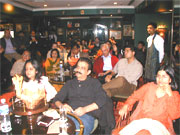The Indian Wine Academy's first Wine One-on-One evening at the India Habitat Centre on February 12 exceeds the expectations of the organisers and succeeds in creating a buzz in the city
The turnout at the first Wine One-on-One evening organised by the Indian Wine Academy at the India Habitat Centre on February 12 far exceeded the expectations of the organisers. "We had made provisions for 20-25, but 35 people enrolled for the session, and their level of participation and knowledge left us pleasantly surprised," informs Subhash Arora, President, Indian Wine Academy. "We had not invited the media, because we thought it was not really a media event, yet teams from the television channels Aaj Tak, Sahara Samay and Headlines Today came to cover the evening. So did a correspondent from The Week magazine."
 The highlight of the evening, though, was the arrival of the Chilean Ambassador Jorge Heine. In his characteristically informal way, Ambassador Heine met with the group, which consisted of lawyers, doctors and even some young expats, and fielded questions on Chilean wines. The highlight of the evening, though, was the arrival of the Chilean Ambassador Jorge Heine. In his characteristically informal way, Ambassador Heine met with the group, which consisted of lawyers, doctors and even some young expats, and fielded questions on Chilean wines.
The wines served during the evening (in long-stemmed glasses, thanks to the flawless planning of the inimitable Vinod Bharti of Old World Hospitality) were Chilean -- the much-acclaimed Cremaschi Furlotti from the Maule Valley, sponsored by Rhine & Raavi Agro Pvt. Ltd. They were good enough to provoke many questions on Carmenere, the grape that disappeared from France only to be re-discovered in Chile in 1994. But the favourites, clearly, were the Sauvignon Blanc and Cabernet Sauvignon.
The level of involvement of the participants was apparent from their informed questions. The oldest among them was Pushpa Bansal, a member of the Delhi Wine Club, but she was most interested in finding out more and more about the wine-making process. And why not? After being a teetotaller all her life, she has started enjoying an occasional glass of wine with her husband.
The concerns of the participants were predictable. Many complained that they got a headache each time they drank wine. The speakers -- Subhash Arora and Sourish Bhattacharyya, Executive Director, Indian Wine Academy -- suggested that they might have been reacting to bad wines with high levels of sulphites, which are used as preservatives in varying proportions (the better the wine, the less it's needed). Avoid them at all costs, the participants were told; Asthmatics must also make sure that the wine they're drinking don't have traces of sulphur -- if they've no way of finding out, it's safer for them to forgo the wine.
Another question concerned about how safe wine drinking was for diabetics. The answer was an unqualified 'yes', because dry wines -- red or white -- have such low levels of residual sugar that there's no cause for worry. Dessert wines, though, are best avoided by diabetics.
One big concern, which kept getting expressed throughout the session, was how to decode the wine lists of restaurants. The Indian Wine Academy's view was eloquently stated by Arora: "The fault lies not with the consumer, but with the restaurants." Arora made a strong case for restaurants making their wine lists intelligble by including brief descriptions of the wines (and not tasting notes that would interest only wine scholars) and going a step further by making wine recommendations for each dish on their food menus. Did we hear voices being raised in agreement?
Another issue was storage. In Delhi, a city experiencing wild extremes of temperature, it's undoubtedly the most important concern for wine connoisseurs. The Indian Wine Academy's stand, again, is quite clear on the subject. Buy a wine cooler, which will take care of all temperature control problems; if the cost of imported coolers is prohibitive, look for the much less expensive local versions, which are about as good as the originals. The cheapest option would be to buy an old refrigerator, which may not be efficient enough for your meats and vegetables, but good enough for your wines, which (whether white or red) should ideally be stored at 12-15 degrees Celsius.
It was an evening well-spent. For Habitat World, it was yet another example of its leadership position in the food and beverage world, which is evident to anyone who visits its restaurants managed by Old World Hospitality. For the Indian Wine Academy, it was a re-affirmation of its faith that there's more interest in wines than we care for and there's a thirst for wine education that must be quenched. Thankfully, two more Wine One-on-One evenings are yet to come. If you haven't enrolled for them, it's not too late. Click Here for the earlier mailer |